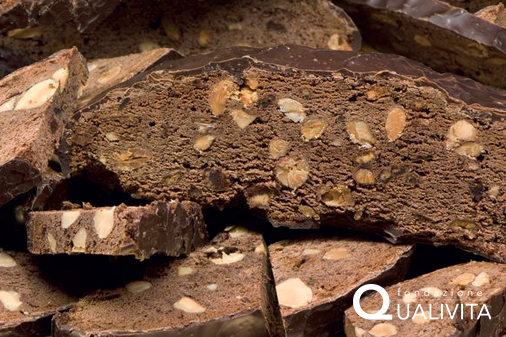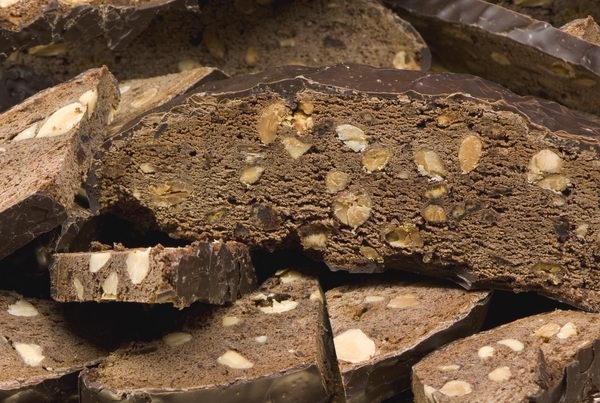Description
Pampapato di Ferrara PGI or Pampepato di Ferrara PGI is a round bakery product with a flat base, obtained from a mixture of flour, candied peel, dry fruit, sugar, cocoa powder and spices, covered with extra dark chocolate.
Production Area
The production area of Pampapato di Ferrara PGI is within the entire territory of the Province of Ferrara, in the Emilia Romagna region.
Production Method
The following ingredients must be used to make Pampapato di Ferrara PGI: type 0 flour, candied orange, lemon and lime peel, toasted sweet almonds with the skin, granulated sugar, bitter cocoa powder, nutmeg and cinnamon, rising agents and water. The optional use of wildflower honey and toasted hazelnuts is also permitted. Processing begins by dissolving the sugar in water. The liquid solution is then added to the other ingredients together with the water, and they are mixed mechanically for 35-45 minutes, until a homogeneous batter is obtained. The batter is then portioned and shaped until it has the typical “spherical-cap” shape. It is then baked in the oven at 180-220 °C for 15-90 minutes, depending on the size of the product. Once cooked, the product is left to age in special rooms with a humidity level of between 75 and 90%, or immersed in an orange-infused alcohol solution. Once the aging process is complete, the product is covered with melted extra dark chocolate.
Appearance and Flavour
The following ingredients must be used to make Pampapato di Ferrara PGI: type 0 flour, candied orange, lemon and lime peel, toasted sweet almonds with the skin, granulated sugar, bitter cocoa powder, nutmeg and cinnamon, rising agents and water. The optional use of wildflower honey and toasted hazelnuts is also permitted. Processing begins by dissolving the sugar in water. The liquid solution is then added to the other ingredients together with the water, and they are mixed mechanically for 35-45 minutes, until a homogeneous batter is obtained. The batter is then portioned and shaped until it has the typical “spherical-cap” shape. It is then baked in the oven at 180-220 °C for 15-90 minutes, depending on the size of the product. Once cooked, the product is left to age in special rooms with a humidity level of between 75 and 90%, or immersed in an orange-infused alcohol solution. Once the aging process is complete, the product is covered with melted extra dark chocolate.
History
The origins of Pampapato di Ferrara PGI date back to the 16th century and are linked to the cloistered nuns of the Corpus Christi convent in Ferrara, who made a type of spicy bread to give as a gift to the high priests during the Christmas period. At the end of the sumptuous noble banquets that took place at the Court of the House of Este, it was tradition to serve a bread-like cake made with spices. Pampapato di Ferrara gained prestige over time, so much so that it was considered worthy of the Pope, which is why it is shaped like a cardinal's hat. In fact, the etymology of this cake and the coexistence of two designations -Pampapato di Ferrara and Pampepato di Ferrara - seem to originate from this custom and the use of spices. The more recent covering of dark chocolate, an unknown ingredient in 1500, was a luxurious and much appreciated variation introduced by a pastry chef in Ferrara in 1902. It met with immediate success and Pampatato soon became Ferrara’s most famous cake.
Gastronomy
Pampapato di Ferrara PGI is mainly eaten at Christmas, although it is now popular year-round. It is best eaten when it is fresh and soft.
Marketing
The product is marketed as Pampapato di Ferrara PGI or Pampepato di Ferrara PGI. It is sold in pieces ranging from 10 g to 3 kg, wrapped in cellophane, aluminium foil or other suitable food-grade materials.
Distinctive Features
The taste and smell of Pampapato di Ferrara PGI are characterized by the spices and dark chocolate covering. The product stands out for its rich ingredients and sumptuousness flavours. It is one the few fat-free confectionary products: there is no milk, butter, oil or lard, although it does contain Omega 3 thanks to the dry fruit.













